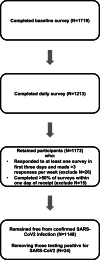A daily diary study into the effects on mental health of COVID-19 pandemic-related behaviors
- PMID: 37132649
- PMCID: PMC8326671
- DOI: 10.1017/S0033291721001896
A daily diary study into the effects on mental health of COVID-19 pandemic-related behaviors
Abstract
Background: Recommendations for promoting mental health during the COVID-19 pandemic include maintaining social contact, through virtual rather than physical contact, moderating substance/alcohol use, and limiting news and media exposure. We seek to understand if these pandemic-related behaviors impact subsequent mental health.
Methods: Daily online survey data were collected on adults during May/June 2020. Measures were of daily physical and virtual (online) contact with others; substance and media use; and indices of psychological striving, struggling and COVID-related worry. Using random-intercept cross-lagged panel analysis, dynamic within-person cross-lagged effects were separated from more static individual differences.
Results: In total, 1148 participants completed daily surveys [657 (57.2%) females, 484 (42.1%) males; mean age 40.6 (s.d. 12.4) years]. Daily increases in news consumed increased COVID-related worrying the next day [cross-lagged estimate = 0.034 (95% CI 0.018-0.049), FDR-adjusted p = 0.00005] and vice versa [0.03 (0.012-0.048), FDR-adjusted p = 0.0017]. Increased media consumption also exacerbated subsequent psychological struggling [0.064 (0.03-0.098), FDR-adjusted p = 0.0005]. There were no significant cross-lagged effects of daily changes in social distancing or virtual contact on later mental health.
Conclusions: We delineate a cycle wherein a daily increase in media consumption results in a subsequent increase in COVID-related worries, which in turn increases daily media consumption. Moreover, the adverse impact of news extended to broader measures of psychological struggling. A similar dynamic did not unfold between the daily amount of physical or virtual contact and subsequent mental health. Findings are consistent with current recommendations to moderate news and media consumption in order to promote mental health.
Keywords: COVID-19 pandemic; cross-lagged effects; media consumption; mental health; social isolation.
Conflict of interest statement
None.
Figures


Similar articles
-
Investigating the relationship of COVID-19 related stress and media consumption with schizotypy, depression, and anxiety in cross-sectional surveys repeated throughout the pandemic in Germany and the UK.Elife. 2022 Jul 4;11:e75893. doi: 10.7554/eLife.75893. Elife. 2022. PMID: 35781372 Free PMC article.
-
A cross-national study of factors associated with women's perinatal mental health and wellbeing during the COVID-19 pandemic.PLoS One. 2021 Apr 21;16(4):e0249780. doi: 10.1371/journal.pone.0249780. eCollection 2021. PLoS One. 2021. PMID: 33882096 Free PMC article.
-
Cross-Lagged Analysis of COVID-19-Related Worry and Media Consumption in a Socioeconomically Disadvantaged Sample of Community Adults.Front Psychol. 2021 Dec 8;12:728629. doi: 10.3389/fpsyg.2021.728629. eCollection 2021. Front Psychol. 2021. PMID: 34955958 Free PMC article.
-
Intersecting factors of disadvantage and discrimination and their effect on daily life during the coronavirus pandemic: the CICADA-ME mixed-methods study.Health Soc Care Deliv Res. 2025 Feb;13(2):1-185. doi: 10.3310/KYTF4381. Health Soc Care Deliv Res. 2025. PMID: 39949202
-
Exploring the relationship between working from home, mental and physical health and wellbeing: a systematic review.Public Health Res (Southampt). 2023 May;11(4):1-100. doi: 10.3310/AHFF6175. Public Health Res (Southampt). 2023. PMID: 37452651
Cited by
-
Study protocol: A national cross-sectional study on psychology and behavior investigation of Chinese residents in 2023.Health Care Sci. 2024 Dec 20;3(6):475-492. doi: 10.1002/hcs2.125. eCollection 2024 Dec. Health Care Sci. 2024. PMID: 39735279 Free PMC article.
-
Impact of Media-Induced Uncertainty on Mental Health: Narrative-Based Perspective.JMIR Ment Health. 2025 Jun 13;12:e68640. doi: 10.2196/68640. JMIR Ment Health. 2025. PMID: 40513096 Free PMC article.
-
Life under stay-at-home orders: a panel study of change in social interaction and emotional wellbeing among older Americans during COVID-19 pandemic.BMC Public Health. 2022 Sep 20;22(1):1777. doi: 10.1186/s12889-022-14103-x. BMC Public Health. 2022. PMID: 36123662 Free PMC article.
-
Adaptation to changes in COVID-19 pandemic severity: Across older adulthood and time scales.Psychol Aging. 2023 Sep;38(6):586-599. doi: 10.1037/pag0000739. Epub 2023 Mar 23. Psychol Aging. 2023. PMID: 36951696 Free PMC article.
-
Daily experiences and adolescent affective wellbeing during the COVID-19 pandemic: The CHESS model.Curr Opin Psychol. 2023 Oct;53:101654. doi: 10.1016/j.copsyc.2023.101654. Epub 2023 Jun 30. Curr Opin Psychol. 2023. PMID: 37517164 Free PMC article. Review.
References
-
- Benjamini, Y., & Hochberg, Y. (1995). Controlling the false discovery rate – a practical and powerful approach to multiple testing. Journal of the Royal Statistical Society Series B-Statistical Methodology, 57(1), 289–300. doi: 10.1111/j.2517-6161.1995.tb02031.x - DOI
-
- Boas, T. C., Christenson, D. P., & Glick, D. M. (2020). Recruiting large online samples in the United States and India: Facebook, mechanical turk, and qualtrics. Political Science Research and Methods, 8(2), 232–250. doi: 10.1017/psrm.2018.28 - DOI
-
- Brannick, M. T. (1995). Critical comment on applying covariance structure modeling. Journal of Organizational Behavior, 16(3), 201–213. doi: 10.1002/job.4030160303 - DOI
Publication types
MeSH terms
Substances
Grants and funding
LinkOut - more resources
Full Text Sources
Medical

